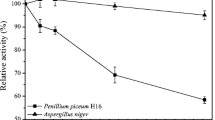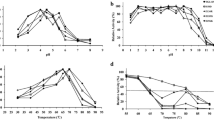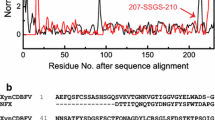Abstract
Higher thermostability is required for 1,3-1,4-β-glucanase to maintain high activity under harsh conditions in the brewing and animal feed industries. In this study, a comprehensive and comparative analysis of thermostability in bacterial β-glucanases was conducted through a method named spatial compartmentalization of mutational hotspots (SCMH), which combined alignment of homologous protein sequences, spatial compartmentalization, and molecular dynamic (MD) simulation. The overall/local flexibility of six homologous β-glucanases was calculated by MD simulation and linearly fitted with enzyme optimal enzymatic temperatures. The calcium region was predicted to be the crucial region for thermostability of bacterial 1,3-1,4-β-glucanases, and optimization of four residue sites in this region by iterative saturation mutagenesis greatly increased the thermostability of a mesophilic β-glucanase (BglT) from Bacillus terquilensis. The E46P/S43E/H205P/S40E mutant showed a 20 °C increase in optimal enzymatic temperature and a 13.8 °C rise in protein melting temperature (T m) compared to wild-type BglT. Its half-life values at 60 and 70 °C were 3.86-fold and 7.13-fold higher than those of wild-type BglT. The specific activity of E46P/S43E/H205P/S40E mutant was increased by 64.4 %, while its stability under acidic environment was improved. The rational design strategy used in this study might be applied to improve the thermostability of other industrial enzymes.






Similar content being viewed by others
References
Arnold FH, Wintrode PL, Miyazaki K, Gershenson A (2001) How enzymes adapt: lessons from directed evolution. Trends Biochem Sci 26:100–106. doi:10.1016/S0968-0004(00)01755-2
Batista PR, de Souza Costa MG, Pascutti PG, Bisch PM, de Souza W (2011) High temperatures enhance cooperative motions between CBM and catalytic domains of a thermostable cellulase: mechanism insights from essential dynamics. Phys Chem Chem Phys 13:13709–13720. doi:10.1039/C0CP02697B
Berendsen HJ, Postma JPM, van Gunsteren WF, DiNola A, Haak J (1984) Molecular dynamics with coupling to an external bath. J Chem Phys 81:3684–3690. doi:10.1063/1.448118
Berendsen H, Grigera J, Straatsma T (1987) The missing term in effective pair potentials. J Phys Chem 91:6269–6271. doi:10.1021/j100308a038
Berezovsky IN, Shakhnovich EI (2005) Physics and evolution of thermophilic adaptation. Proc Nat Acad Sci USA 102:12742–12747. doi:10.1073/pnas.0503890102
Biasini M, Bienert S, Waterhouse A, Arnold K, Studer G, Schmidt T, Kiefer F, Cassarino TG, Bertoni M, Bordoli L (2014) SWISS-MODEL: modelling protein tertiary and quaternary structure using evolutionary information. Nucl Acid Res 42:W252-8. doi:10.1093/nar/gku340
Bradford MM (1976) A rapid and sensitive method for the quantitation of microgram quantities of protein utilizing the principle of protein-dye binding. Anal Biochem 72:248–254. doi:10.1016/0003-2697(76)90527-3
Chaari F, Belghith-Fendri L, Blibech M, Driss D, Ellouzi SZ, Ellouz-Chaabouni S (2014) Biochemical characterization of a lichenase from Penicillium occitanis Pol6 and its potential application in the brewing industry. Process Biochem 49:1040–1046. doi:10.1016/j.procbio.2014.02.023
Chen Y-C, Chiang Y-C, Hsu F-Y, Tsai L-C, Cheng H-L (2012) Structural modeling and further improvement in pH stability and activity of a highly-active xylanase from an uncultured rumen fungus. Bioresource Technol 123:125–134. doi:10.1016/j.biortech.2012.05.142
D’Amico S, Claverie P, Collins T, Georlette D, Gratia E, Hoyoux A, Meuwis M-A, Feller G, Gerday C (2002) Molecular basis of cold adaptation. Phil Trans Roy Soc London B 357:917–925. doi:10.1098/rstb.2002.1105
D’Amico S, Gerday C, Feller G (2003) Temperature adaptation of proteins: engineering mesophilic-like activity and stability in a cold-adapted alpha-amylase. J Mol Biol 332:981–988. doi:10.1016/j.jmb.2003.07.014
Darden T, York D, Pedersen L (1993) Particle mesh Ewald: an N⋅log (N) method for Ewald sums in large systems. J Chem Phys 98:10089–10092. doi:10.1063/1.464397
Declerck N, Machius M, Joyet P, Wiegand G, Huber R, Gaillardin C (2003) Hyperthermostabilization of Bacillus licheniformis α-amylase and modulation of its stability over a 50 °C temperature range. Protein Eng 16:287–293. doi:10.1093/proeng/gzg032
Di Marino D, Achsel T, Lacoux C, Falconi M, Bagni C (2014) Molecular dynamics simulations show how the FMRP Ile304Asn mutation destabilizes the KH2 domain structure and affects its function. J Biomol Struct Dyn 32:337–350. doi:10.1080/07391102.2013.768552
Eijsink VG, Bjørk A, Gåseidnes S, Sirevåg R, Synstad B, van den Burg B, Vriend G (2004) Rational engineering of enzyme stability. J Biotechnol 113:105–120. doi:10.1016/j.jbiotec.2004.03.026
Fei B, Xu H, Cao Y, Ma S, Guo H, Song T, Qiao D, Cao Y (2013) A multi-factors rational design strategy for enhancing the thermostability of Escherichia coli AppA phytase. J Ind Microbiol Biotechnol 40:457–464. doi:10.1007/s10295-013-1260-z
Fuhrmann GF, Völker B (1993) Misuse of graphical analysis in nonlinear sugar transport kinetics by Eadie-Hofstee plots. BBA-Biomembranes 1145:180–182. doi:10.1016/0005-2736(93)90396-H
Furtado GP, Ribeiro LF, Santos CR, Tonoli CC, De Souza AR, Oliveira RR, Murakami MT, Ward RJ (2011) Biochemical and structural characterization of a β-1,3-1,4-glucanase from Bacillus subtilis 168. Process Biochem 46:1202–1206. doi:10.1016/j.procbio.2011.01.037
Gargallo R, Cedano J, Mozo-Villarias A, Querol E, Oliva B (2006) Study of the influence of temperature on the dynamics of the catalytic cleft in 1,3-1,4-β-glucanase by molecular dynamics simulations. J Mol Model 12:835–845. doi:10.1007/s00894-006-0110-6
Hahn M, Keitel T, Heinemann U (1995a) Crystal and molecular structure at 0.16-nm resolution of the hybrid Bacillus endo-1,3-1,4-β-D-glucan 4-glucanohydrolase H(A16-M. Eur J Biochem 232:849–858. doi:10.1111/j.1432-1033.1995.849zz.x
Hahn M, Olsen O, Politz O, Borriss R, Heinemann U (1995b) Crystal structure and site-directed mutagenesis of Bacillus macerans endo-1,3-1,4-glucanase. J Biol Chem 270:3081–3088
Hahn M, Pons J, Planas A, Querol E, Heinemann U (1995c) Crystal structure of Bacillus licheniformis 1,3-1,4-β-d-glucan 4-glucanohydrolase at 1.8 Å resolution. FEBS Lett 374:221–224. doi:10.1016/0014-5793(95)01111-Q
Keitel T, Meldgaard M, Heinemann U (1994) Cation binding to a Bacillus (1,3-1,4)-β-glucanase geometry, affinity and effect on protein stability. Eur J Biochem 222:203–214. doi:10.1111/j.1432-1033.1994.tb18858.x
Kumar S, Tsai C-J, Nussinov R (2000) Factors enhancing protein thermostability. Protein Eng 13:179–191. doi:10.1093/protein/13.3.179
Lewis MJ, Young TW (2012) Brewing. Springer Science & Business Media
Li C, Ban X, Gu Z, Li Z (2013) Calcium ion contribution to thermostability of cyclodextrin glycosyltransferase is closely related to calcium-binding site CaIII. J Agr Food Chem 61:8836–8841. doi:10.1021/jf4024273
Liu Y-h, Lu F-p, Li Y, Wang J-l, Gao C (2008) Acid stabilization of Bacillus licheniformis alpha amylase through introduction of mutations. Appl Microbiol Biotechnol 80:795–803. doi:10.1007/s00253-008-1580-5
Luo Z, Gao Q, Li X, Bao J (2014) Cloning of LicB from Clostridium thermocellum and its efficient secretive expression of thermostable β-1,3-1,4-glucanase. Appl Biochem Biotechnol 173:562–570. doi:10.1007/s12010-014-0863-9
Michaux C, Pouyez J, Mayard A, Vandurm P, Housen I, Wouters J (2010) Structural insights into the acidophilic pH adaptation of a novel endo-1,4-β-xylanase from Scytalidium acidophilum. Biochimie 92:1407–1415. doi:10.1016/j.biochi.2010.07.003
Niu C, Zhu L, Wang J, Li Q (2014) Simultaneous enhanced catalytic activity and thermostability of a 1,3-1,4-β-glucanase from Bacillus amyloliqueformis by chemical modification of lysine residues. Biotechnol Lett 36:2453–2460. doi:10.1007/s10529-014-1616-0
Niu C, Zhu L, Zhu P, Li Q (2015) Lysine-based site-directed mutagenesis increased rigid β-sheets structure and thermostability of mesophilic 1,3-1,4-β-glucanase . doi:10.1021/acs.jafc.5b00480J Agr Food Chem
Oostenbrink C, Villa A, Mark AE, Van Gunsteren WF (2004) A biomolecular force field based on the free enthalpy of hydration and solvation: the GROMOS force-field parameter sets 53A5 and 53A6. J Comput Chem 25:1656–1676. doi:10.1002/jcc.20090
Parrinello M, Rahman A (1981) Polymorphic transitions in single crystals: a new molecular dynamics method. J Appl Phys 52:7182–7190. doi:10.1063/1.328693
Paul M, Hazra M, Barman A, Hazra S (2014) Comparative molecular dynamics simulation studies for determining factors contributing to the thermostability of chemotaxis protein “CheY. J Biomol Struct Dyn 32:928–949. doi:10.1080/07391102.2013.799438
Perl D, Schmid FX (2001) Electrostatic stabilization of a thermophilic cold shock protein. J Mol Biol 313:343–357. doi:10.1006/jmbi.2001.5050
Pikkemaat MG, Linssen AB, Berendsen HJ, Janssen DB (2002) Molecular dynamics simulations as a tool for improving protein stability. Protein Eng 15:185–192. doi:10.1093/protein/15.3.185
Pronk S, Páll S, Schulz R, Larsson P, Bjelkmar P, Apostolov R, Shirts MR, Smith JC, Kasson PM, van der Spoel D (2013) GROMACS 4.5: a high-throughput and highly parallel open source molecular simulation toolkit. Bioinformatics. doi:10.1093/bioinformatics/btt055
Querol E, PerezPons JA, MozoVillarias A (1996) Analysis of protein conformational characteristics related to thermostability. Protein Eng 9:265–271. doi:10.1093/protein/9.3.265
Reetz MT, Carballeira JD, Vogel A (2006) Iterative saturation mutagenesis on the basis of B factors as a strategy for increasing protein thermostability. Angew Chem Int Ed 45:7745–7751. doi:10.1002/anie.200602795
Schimming S, Schwarz WH, Staudenbauer WL (1991) Properties of a thermoactive β-1,3-1,4-glucanase (lichenase) from Clostridium thermocellum expressed in Escherichia coli. Biochem Biophys Res Commun 177:447–452. doi:10.1016/0006-291X(91)92004-4
Schumann J, Bohm G, Schumacher G, Rudolph R, Jaenicke R (1993) Stabilization of creatinase from Pseudomonas putida by random mutagenesis. Protein Sci 2:1612–1620. doi:10.1002/pro.5560021007
Spring P, Newman K, Wenk C, Messikommer R, Vranjes MV (1996) Effect of pelleting temperature on the activity of different enzymes. Poultry Sci 75:357–361. doi:10.3382/ps.0750357
Umemoto H, Ihsanawati IM, Yatsunami R, Fukui T, Kumasaka T, Tanaka N, Nakamura S (2009) Improvement of alkaliphily of Bacillus alkaline xylanase by introducing amino acid substitutions both on catalytic cleft and protein surface. Biosci Biotechnol Biochem 73:965–967. doi:10.1271/bbb.80869
Vetriani C, Maeder DL, Tolliday N, Yip KSP, Stillman TJ, Britton KL, Rice DW, Klump HH, Robb FT (1998) Protein thermostability above 100 degrees C: a key role for ionic interactions. Proc Nat Acad Sci USA 95:12300–12305. doi:10.1073/pnas.95.21.12300
Wang J, Niu C, Liu X, Chen X, Li Q (2014) Characterization of a new 1,3-1,4-β-glucanase gene from Bacillus tequilensis CGX5-1. Appl Biochem Biotechnol 173:826–837. doi:10.1007/s12010-014-0900-8
Watanabe K, Hata Y, Kizaki H, Katsube Y, Suzuki Y (1997) The refined crystal structure of Bacillus cereus oligo-1,6-glucosidase at 2.0 Å resolution: structural characterization of proline-substitution sites for protein thermostabilization. J Mol Biol 269:142–153. doi:10.1006/jmbi.1997.1018
Whitmore L, Wallace BA (2008) Protein secondary structure analyses from circular dichroism spectroscopy: methods and reference databases. Biopolymers 89:392–400. doi:10.1002/bip.20853
Zhang W, Mullaney EJ, Lei XG (2007) Adopting selected hydrogen bonding and ionic interactions from Aspergillus fumigatus phytase structure improves the thermostability of Aspergillus niger PhyA phytase. Appl Environ Microbiol 73:3069–3076. doi:10.1128/AEM.02970-06
Zhou X-X, Wang Y-B, Pan Y-J, Li W-F (2008) Differences in amino acids composition and coupling patterns between mesophilic and thermophilic proteins. Amino Acids 34:25–33. doi:10.1007/s00726-007-0589-x
Author information
Authors and Affiliations
Corresponding author
Ethics declarations
Funding
This study was funded by the National High Technology Research and Development Program 863 (No. 2013AA102106), National Science Foundation (No. 31271919, No. 31571942, and No. 31301539), Fundamental Research Funds for the Central Universities (JUSRP51504, JUSRP51402A, and JUDCF13008), Priority Academic Program Development of Jiangsu Higher Education Institutions (PAPD), and Program of Introducing Talents of Discipline to Universities (No. 111-2-06).
Conflict of interest
Chengtuo Niu declares that he has no conflict of interest.
Linjiang Zhu declares that he has no conflict of interest.
Xin Xu declares that he has no conflict of interest.
Qi Li declares that she has no conflict of interest.
Ethical approval
This article does not contain any studies with human participants or animals performed by any of the authors.
Additional information
Chengtuo Niu and Linjiang Zhu contributed equally to this work
Electronic supplementary material
ESM 1
(PDF 1019 kb)
Rights and permissions
About this article
Cite this article
Niu, C., Zhu, L., Xu, X. et al. Rational design of thermostability in bacterial 1,3-1,4-β-glucanases through spatial compartmentalization of mutational hotspots. Appl Microbiol Biotechnol 101, 1085–1097 (2017). https://doi.org/10.1007/s00253-016-7826-8
Received:
Revised:
Accepted:
Published:
Issue Date:
DOI: https://doi.org/10.1007/s00253-016-7826-8




